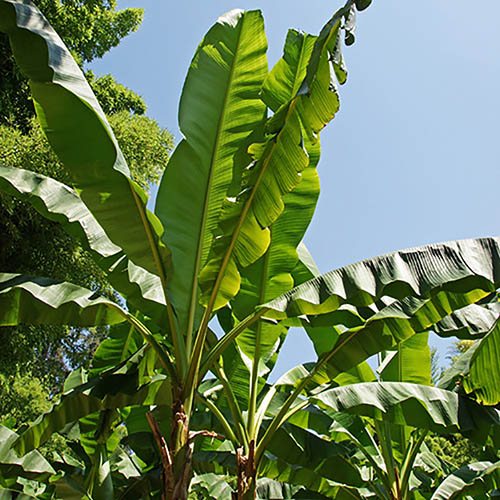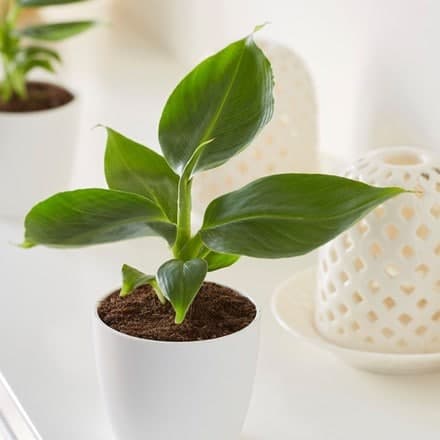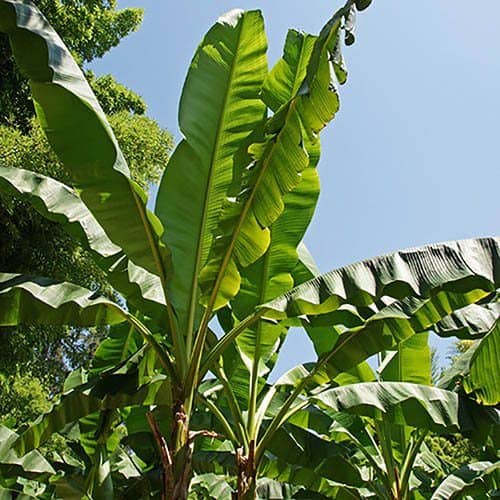Musa basjoo – Japanese fibre banana, Japanese root-hardy banana is the hardiest of all bananas in the UK and the most easily obtainable. An absolutely essential plant for the exotic garden and has been in out garden for many years. Hailing from the volcanic islands in the Ryukyu archipelago, formerly Chinese and now Japanese, stretching between southern Japan and northern Taiwan in the western Pacific Ocean. Although the common name Japanese fibre banana is applied to Musa basjoo and it was introduced to the British Isles from Japan, M. basjoo is not Japanese and it’s not grown for fibre; it was introduced to Japan from China and has only ever been grown in Japan as an ornamental.
IN THIS ARTICLE
Musa Basjoo – The fundamental plant for your exotic garden!

Musa basjoo – Hardy Japanese Banana Plants
It has midgreen leaves with a pale green midrib growing about 2.5 cm a day in summer, reaching up to 1.8 m long or more and 0.5 m wide, in other words -huge! The pseudostem (stem/trunk) can reach 2.7 m tall, making large plants up to 5.4 m high and 3.65m across, with long arching leaves.
With time it will become a clump-forming/spreading, multi-stemmed plant. With age each stem produces drooping pale yellow flowers with brownish bracts, followed by small green inedible fruit. Flowering stems die after fruiting and are replaced by many new pups around the base. The stem can take several degrees of frost (with protection, –10°C and lower), though leaves tend to burn at –2°C. The stems if killed will re-shoot from the ground in spring, hence the common name Japanese root-hardy banana. Click here to find out how to care for banana plants, or how to over winter banana plants.
Common Name: Japanese fibre banana, Japanese root-hardy banana
Latin Name: Musa Basjoo
Tenderness Rating: Very root hardy, upper growth hardy with protection
Ease of growing: Easy
Position: Full sun to dappled shade
Soil Condition: Well drained fertile soil.
Other great banana trees or banana plants to grow and buy in the UK are of course the Musa Basjoo, Ensete ventricosum ‘Maurelii’ – Red Abyssinian Ethiopian banana, Musa lasiocarpa, Musa Sikkimensis and Musa Acuminata Dwarf Cavendish.
- How to overwinter banana plants through the winter months
- GROW GUIDE: How to grow banana plants
- What Should I Plant with Musa Basjoo?
- Can you grow a banana plant indoors?
- Can you grow banana fruit in a UK garden?
Where to buy Musa Basjoo or find for sale in the UK:
Other types of banana trees / banana plants you can buy and grow in the UK
Musa Basjoo – The Hardy Japanese Banana That Defies the Cold
Musa Basjoo, also known as the Japanese Fiber Banana or Hardy Banana, is a unique banana species native to Japan. It is a perennial plant that has gained popularity among gardeners and horticulturists worldwide due to its ability to withstand colder climates, unlike most other banana plants. In this article, we will explore the origins, characteristics, and cultivation of this extraordinary banana plant.
Origins and Distribution
The Musa Basjoo is native to the Ryukyu Islands of Japan, where it has been cultivated for centuries for its fibres. In the mid-19th century, the plant made its way to Europe, and by the late 20th century, it gained popularity in North America for its hardiness and ornamental value. Today, Musa Basjoo can be found in gardens across various temperate regions, including the United States, Canada, and Europe.
Characteristics of Musa Basjoo
The Musa Basjoo is known for its large, lush leaves that can grow up to 6 feet in length, giving it a tropical appearance. It reaches an average height of 10-15 feet, but can grow taller in ideal conditions. The plant produces small, yellow flowers that give way to inedible green bananas, which are mostly used for ornamental purposes. Despite its cold-hardiness, the Musa Basjoo is not frost-tolerant, and its leaves may be damaged by frost.
Cold Hardiness of Musa Basjoo
What sets the Musa Basjoo apart from other banana species is its ability to withstand cold temperatures, down to -10 degrees Celsius (14 degrees Fahrenheit) with wrapping and protection. This makes it possible for gardeners in colder climates to cultivate a tropical-looking plant without needing to bring it indoors during the winter months. The plant’s rhizome, or underground stem, is the key to its cold tolerance, as it can survive freezing temperatures even if the above-ground foliage dies back.
Cultivation of Musa Basjoo
Musa Basjoo plants prefer well-draining soil with a pH level of 6.0 to 6.5. They thrive in full sun but can tolerate partial shade. To achieve optimal growth, provide the plant with ample water and fertiliser during the growing season.
In regions where winter temperatures drop below freezing, it is essential to protect the plant’s rhizome by applying a thick layer of mulch, such as straw or leaves, around the base. This will insulate the rhizome and help it survive the cold. Once the warmer temperatures return, new shoots will emerge from the rhizome, and the plant will quickly regain its lush appearance.
Propagating Musa Basjoo
Musa Basjoo can be propagated through division, separating the suckers (new shoots) that emerge from the rhizome. These suckers can be carefully removed from the parent plant and transplanted into a new location or a container. The best time to propagate Musa Basjoo is during the spring or early summer when the plant is actively growing.
Summary
The Musa Basjoo is an exceptional banana species that adds a tropical touch to gardens in colder climates. Its ability to withstand low temperatures and its striking appearance make it an attractive choice for gardeners and horticulturists. By following proper cultivation techniques, anyone can enjoy the lush, exotic beauty of the Japanese Fiber Banana in their own backyard.
















